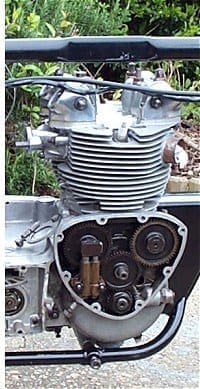
It’s the Moment Of Truth for Dave’s rebuild project. The Tiger is back in one piece and he’s got to get it going. So. Will it start?
So this was it, engine oil in, gearbox oil in, ignore the leaks from the gearbox due to no sealant and fit the petrol tank, fuel tap and pipe. Right, petrol in, fuel on, watch the fuel flow through the pipe and into the carburettor and then to my disappointment, watch fuel leaking from the banjo fitting. Not a problem, off with the banjo fitting, add a small washer and tighten the banjo as much as possible. I turned the fuel back on and watched again in horror to see fuel now leaking from the float cover…
This was really starting to annoy me as I had replaced all the washers and gaskets on the carburettor before I re-fitted it. It was no good. I had to remove the carburettor and completely strip and rebuild it to be sure that it wouldn’t leak. By the time I had done this I had lost my momentum and enthusiasm so postponed the start to the following day.
I started early the next day and tentatively turned on the fuel, it was looking good with no signs of leaks. I depressed the tickler until the first signs of petrol appeared, then I noticed that petrol was also running from the back of the carb and filling the air filter box. This wasn’t good — so quick, turn off the fuel and off with the air filter.
Still keen to try and start the engine I thought ‘I can sort that out later’. So with a carb full of fuel I gave a mighty kick on the kickstart.
Nothing.
Never mind, try again and…
Nothing.
This went on for about an hour trying all the possible reasons for a non-start. I removed the plugs look for signs of fuel, checked the plug gaps leads, etc. Still nothing.
At this point I started to have serious doubts about the ignition timing. As I said before, I was using the original Energy Transfer system, which everyone I had sought advice from seemed to be of the opinion that it was no good and should be replaced with an electronic system. Except one nice gentleman from Canada who emailed me some literature on the system. He had run a number of Triumphs with this without any problems. It couldn’t be all bad?
|
Not to be defeated I went back to basics and went through the process of setting the static timing. This all seemed OK, re-check the points and leads, and on with the distributor cap. Just to be sure I shut myself in the garage with a plug held on the block and gave the engine a hefty boot on the kick start. To my great satisfaction, a good healthy spark, from both plugs too. Seems the chap in Canada was right after all. So with a good spark it must be fuel, and I went back to the carb. Everything looked OK except the flooding, so I drained the carb and started again. More frantic gymnastics on the kickstart and… still nothing. At one point I thought I heard a pop from one of the cylinders but I think that was just wishful thinking. By this time I had been at it for about four and a half hours and was about ready to give up. Just one last thought. I took of the distributor cap and inlet tappet inspection cover and turned the engine over. As I watched the rotor arm come round on the compression stroke it dawned on me that the leads were back to front. Could this be the problem? |
I quickly replaced the distributor cap and swapped the leads at the plugs, filled the carb again, big swing on the kickstart and — to my amazement – there was a great thump as the engine fired up for the first time since I don’t know when. The engine was running really rough and wouldn’t rev, but it was running, that’s all that mattered.
It was running and I was ecstatic.
At this point most of the neighbours emerged to see what was causing this outrageous noise. I should point out that although I had fitted both downpipes, I had only fitted one of the silencers. (I hadn’t fitted the primary cover yet and the pipes would get in the way). It was very loud but it was music to my ears.
Then to my horror I noticed a large puddle of oil trickling across the top of the engine above the gearbox. Oh dear, my heart sank and I turned it off quick to investigate. As I mentioned earlier, I hadn’t really stripped the engine, only made brief inspections down the barrels and timing covers, so I was expecting the worst…
I needn’t have worried as the oil was coming from a loose nut on the rocker feed pipe, so at least I knew that the oil pump was working and the rockers were going to be suitably lubricated! A quick whiz with the spanners had that sorted and it started again first kick, still rough but running all the same.
It was a very proud and relieved man that returned the Tiger to the garage that evening. It had taken all weekend and there were still a mountain of jobs to do but the satisfaction was almost indescribable. And the ignition system worked!
Patient reassembly, or mad rush to finish?





